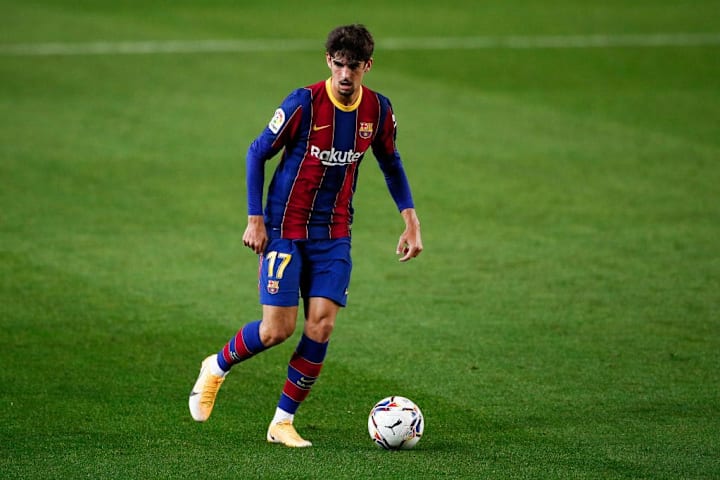
When Barcelona lined up against Real Betis on Saturday afternoon, Lionel Messi was sitting in the stands but the club’s leading scorer of the season was still on the pitch.
Ansu Fati, barely 18 years old and in his second campaign of senior football, has made a lightening start to the season, rattling in five goals and two assists from his opening ten appearances. Yet, just as the club looked to have gone an entire week without some bubbling turmoil rising to the surface, their fleet-footed teenager didn’t return for the second half.
Ansu Fati will be out for around four months! ? https://t.co/4G8CEtXKx3
— 90min (@90min_Football) November 9, 2020
Former Barcelona academy player Antonio Sanabria levelled the score in first half stoppage time but worse news was hinted at during the interval. In the days after the match, Fati was forced to undergo surgery on his knee, ruling the newly-capped Spain international out for four months.
Messi came on in Fati’s place for the second 45 minutes, inspiring Barcelona to an emphatic victory. Yet, while the Argentine number ten rolled back the years with a bewitching display, his second goal of the game was just his first from open play all season. Fati may have only been given a first-team squad number in September but he has rapidly become a worryingly important player for a Barcelona side which will have to cope without him for the foreseeable future.
From the opening ten games of Ronald Koeman’s tenure as Barcelona boss, the Dutchman is yet to stray from his 4-2-3-1 system. Fati – who has featured in every match so far, starting eight of them – has either been deployed from the left wing or through the middle in front of an attacking midfielder.
With Luis Suarez now decked out in Atletico Madrid’s red and white, dovetailing with another of La Liga’s youthful sensations, Barcelona’s options at centre-forward are limited to Messi, Antoine Griezmann and the lesser spotted Martin Braithwaite.
? @AntoGriezmann & #Messi ??? pic.twitter.com/WZjCd1y9k9
— FC Barcelona (@FCBarcelona) November 9, 2020
Alongside that trident, Philippe Coutinho had begun to hint at a return to his best form as the side’s central creator, before picking up an injury which is scheduled to sideline him until mid-November. However, the former Liverpool man looked desperately isolated when shunted out wide on the left against Real Madrid and, much like Griezmann, is better suited to a role through the middle.
And so, Fati’s primary replacement lie on the flanks and come in the form of the club’s two out and out wingers – Ousmane Dembele and Francisco Trincao.
Following the stop-start pattern of his Barcelona career to date, Dembele is in the midst of a high having scored three goals in his last six outings, including the opener against Betis. So far the Frenchman has been mainly used on the right wing, but a change in flank shouldn’t be a problem given his absurd ambidexterity (he describes himself as left-footed but takes penalties with his right foot).
With Dembele on the left, Messi could easily be used on the right but it also presents an opportunity for Trincao. The left-footed Portugal international arrived in Catalonia this summer and has shown flashes of the talent which persuaded Barcelona to part ways with £26m in his raft of cameo appearances.

Trincao’s impressive start to life in Barcelona has only been outshone by the immediate settling of fellow summer arrival Pedri. In one of the two games Fati didn’t start, Koeman opted for the 17-year-old Spaniard on the left against Juventus. In a performance well beyond his tender years, Pedri – the only player younger than Fati in Barcelona’s squad – turned the experienced Juan Cuadrado inside out, floating effortlessly around the pitch, rarely squandering possession and knitting the play together.
However, given his tendency to drift infield when starting out wide, deploying Pedri in this role works best when Jordi Alba, with his lung-bursting surges on the overlap, is there to offer width.
Alternatively, Barcelona’s attack may benefit from a wider change of system in Fati’s absence. If Koeman were to revert to the club’s traditional 4-3-3 – with Frenkie de Jong in place of Sergio Busquets at the base of midfield – it may avoid the congestion which has tended to build up when Barcelona’s rotating carousel of as many as four number tens clog the centre of the pitch.
In addition, adding another midfielder – preferably one more mobile than Busquets – may help Barcelona quell the quality of chances their opponents have been afforded by bypassing their double pivot.
Stripped of Fati, Barcelona return from November’s international break lying eighth in the table with the brutal challenge of travelling to an imperious Atletico Madrid.
Barcelona may not be achieving the scintillating standard forever expected of them, but this lowly league position isn’t supported by the team’s underlying numbers, with their expected goals difference (xGD) per game ranking them third in the division (according to FBref).
However, the Blaugrana racked up those figures with Fati safely ensconced in their attack. How Koeman lines up in his absence and how this configuration performs until his projected return in March, will define Barcelona’s season.
Let’